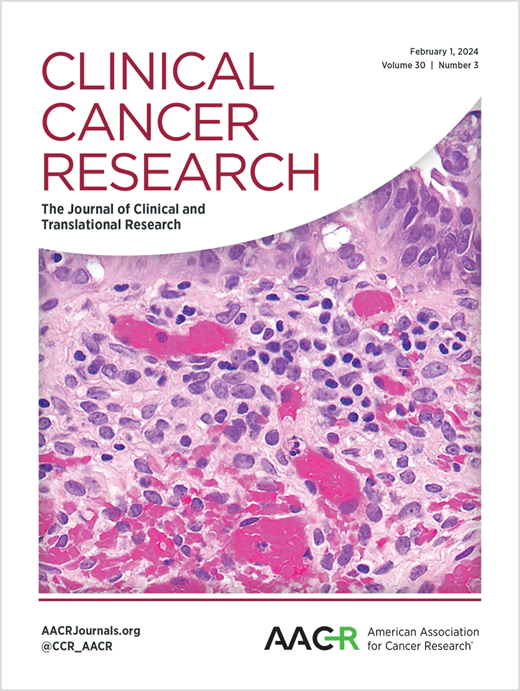Venetoclax plus modified-intensity Idarubicin and Cytarabine treatment as first-line treatment for newly diagnosed pediatric acute myeloid leukemia
IF 10
1区 医学
Q1 ONCOLOGY
引用次数: 0
Abstract
Purpose: Venetoclax (VEN) has shown excellent activity in eliminating acute myeloid leukemia (AML) blasts in preclinical and clinical trials, but clinical data in pediatric newly diagnosed AML (ND-AML) remain limited. We evaluated VEN plus modified-intensity idarubicin and cytarabine chemotherapy (VIA) in childhood ND-AML. Experimental design: In an open-label, single-arm, multi-center prospective clinical trial, 65 ND-AML pediatric patients received VIA induction (VEN and modified-intensity cytarabine and idarubicin). Consolidation was guided on response to induction and individualized risk stratification. Primary end point was complete remission (CR) and measurable residual disease (MRD) response rates. Results: After induction cycle 1, CR and MRD negativity was 90.8% and 78.5%, increasing to 96.8% and 87.3% following induction cycle 2. 28 (43.2%) patients underwent hematopoietic stem cell transplantation (HSCT) without engraftment failure. CBF AML [t(8;21) and inv(16)/t(16;16)] patients achieved a favorable response rate, but the median log10 reduction of transcript levels was suboptimal [-1.7 (cycle 1) and -2.6 (cycle 2) for RUNX1::RUNX1T1, -2.3 and -2.5 for CBFB::MYH11]. Disease relapse was frequently observed in KIT mutation, RUNX1::RUNX1T1 and CBFB::MYH11. The most common grade 3-4 toxicities were hematological toxicities and febrile neutropenia (FN). No treatment-related deaths occurred. With a median follow-up of 15.7 months, the estimated 12-month overall survival and event-free survival was 92.3% (95% CI 86.0-99.8) and 79.1% (95% CI 69.6-90.0). MRD negativity post cycle 1 correlated with superior long-term survival (P < 0.001). Conclusions: VIA regimen is highly effective and relatively safe in children with ND-AML, with deep remission and favorable survival outcomes.Venetoclax联合改良强度依达柔比星和阿糖胞苷治疗新诊断的儿童急性髓性白血病的一线治疗
目的:Venetoclax (VEN)在临床前和临床试验中显示出良好的消除急性髓性白血病(AML)原细胞的活性,但在儿科新诊断AML (ND-AML)中的临床数据仍然有限。我们评估了VEN联合改良强度伊达柔比星和阿糖胞苷化疗(VIA)治疗儿童ND-AML的效果。实验设计:在一项开放标签、单臂、多中心前瞻性临床试验中,65名ND-AML儿童患者接受了VIA诱导(VEN和改良强度阿糖胞苷和伊达柔比星)。巩固以应对诱导和个体化风险分层为指导。主要终点是完全缓解(CR)和可测量的残留疾病(MRD)缓解率。结果:诱导周期1后CR和MRD阴性分别为90.8%和78.5%,诱导周期2后CR和MRD阴性分别为96.8%和87.3%。28例(43.2%)患者接受了造血干细胞移植(HSCT),未发生移植失败。CBF AML [t(8;21)和inv(16)/t(16;16)]患者获得了良好的缓解率,但转录物水平的中位log10降低不是最理想的[RUNX1::RUNX1T1的-1.7(周期1)和-2.6(周期2),CBFB::MYH11的-2.3和-2.5]。在KIT突变、RUNX1::RUNX1T1和CBFB::MYH11中经常观察到疾病复发。最常见的3-4级毒性是血液学毒性和发热性中性粒细胞减少症(FN)。无治疗相关死亡发生。中位随访时间为15.7个月,估计12个月总生存率和无事件生存率分别为92.3% (95% CI 86.0-99.8)和79.1% (95% CI 69.6-90.0)。周期1后MRD阴性与较好的长期生存相关(P <;0.001)。结论:VIA方案治疗ND-AML儿童非常有效且相对安全,具有深度缓解和良好的生存结局。
本文章由计算机程序翻译,如有差异,请以英文原文为准。
求助全文
约1分钟内获得全文
求助全文
来源期刊

Clinical Cancer Research
医学-肿瘤学
CiteScore
20.10
自引率
1.70%
发文量
1207
审稿时长
2.1 months
期刊介绍:
Clinical Cancer Research is a journal focusing on groundbreaking research in cancer, specifically in the areas where the laboratory and the clinic intersect. Our primary interest lies in clinical trials that investigate novel treatments, accompanied by research on pharmacology, molecular alterations, and biomarkers that can predict response or resistance to these treatments. Furthermore, we prioritize laboratory and animal studies that explore new drugs and targeted agents with the potential to advance to clinical trials. We also encourage research on targetable mechanisms of cancer development, progression, and metastasis.
 求助内容:
求助内容: 应助结果提醒方式:
应助结果提醒方式:


